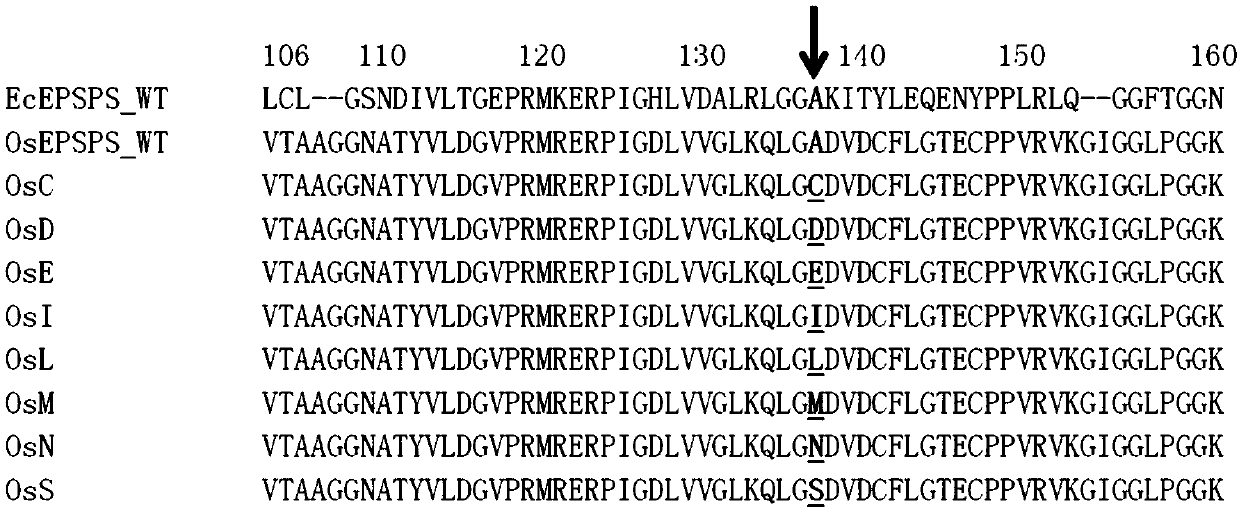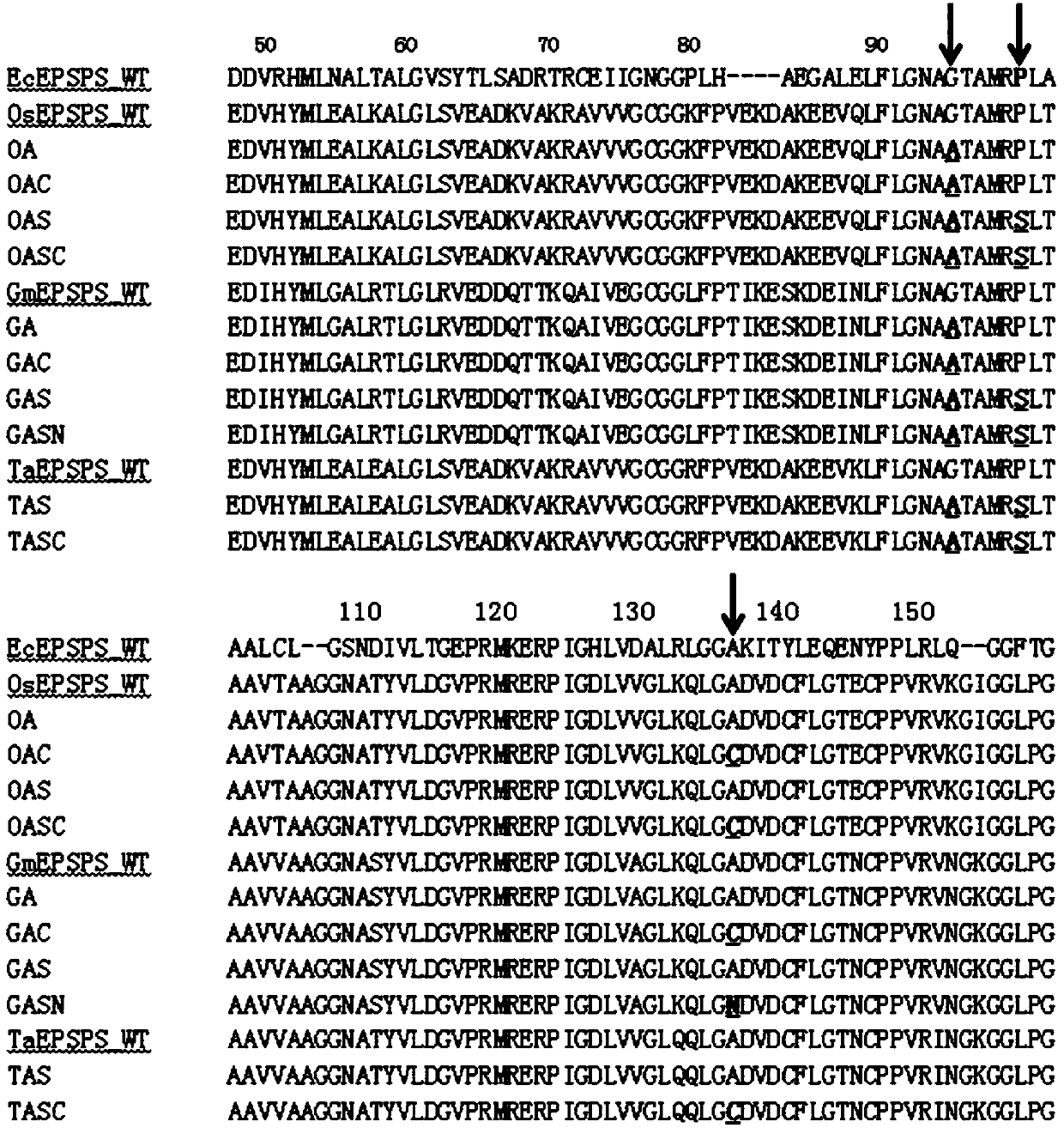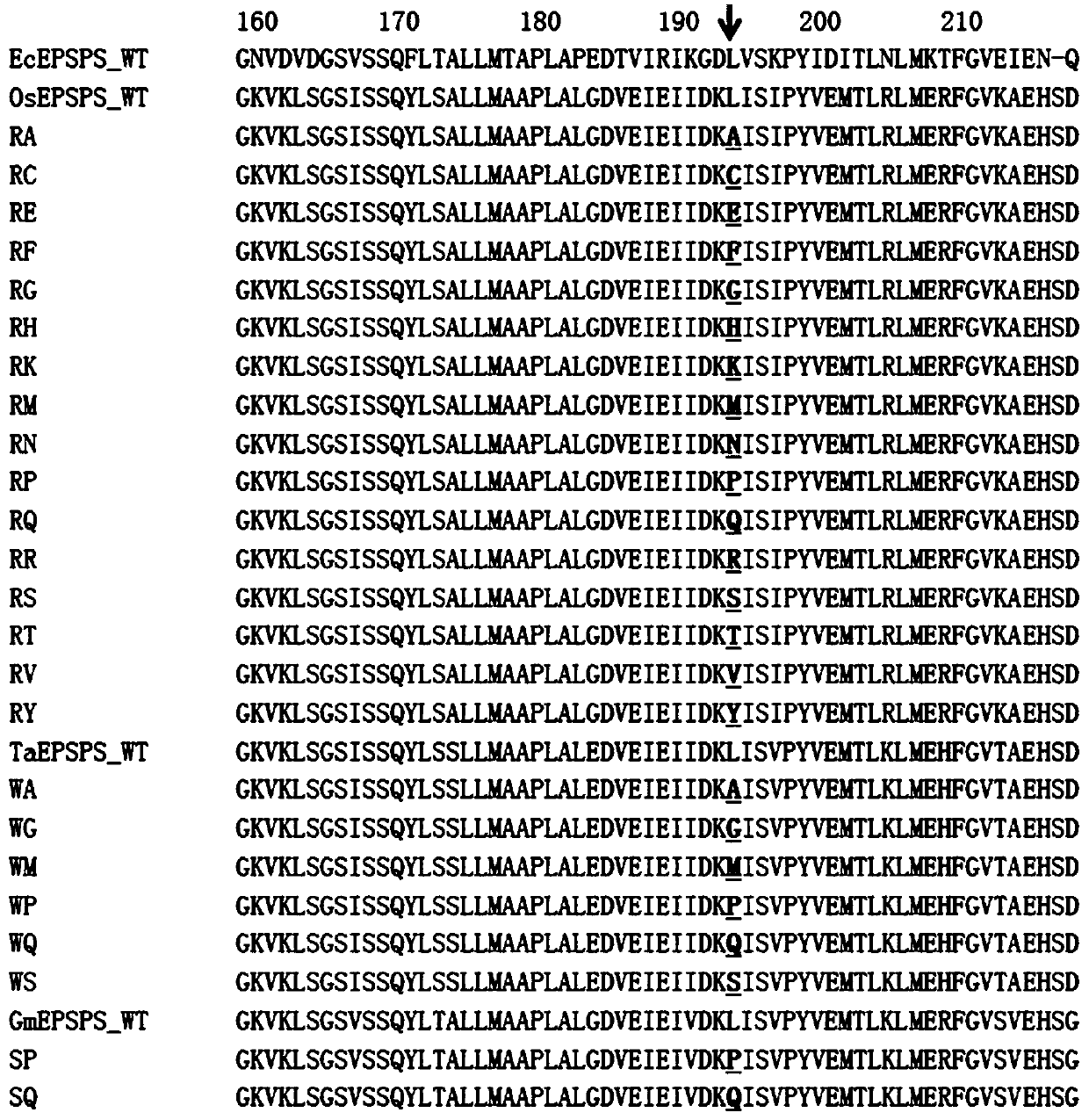Plant EPSPS mutant containing A138X1 and L195X2 mutation and coding genes and application of plant EPSPS mutant
A technology of L195X2 and A38X1, applied in the field of genetic engineering, can solve the problems of low acceptance of transgenic crops, achieve the effects of maintaining the catalytic activity of biological enzymes, improving resistance, and broad application prospects
- Summary
- Abstract
- Description
- Claims
- Application Information
AI Technical Summary
Problems solved by technology
Method used
Image
Examples
Embodiment 1
[0113] The rice EPSPS mutants provided in this example are named as OsC, OsD, OsE, OsI, OsL, OsM, OsN and OsS, and their amino acid sequences are respectively as SEQ ID NO.49, SEQ ID NO.50, SEQ ID NO.51 , SEQ ID NO.52, SEQ ID NO.53, SEQ ID NO.54, SEQ ID NO.55, SEQ ID NO.56.
[0114] The rice EPSPS mutant provided in this example is composed of wild-type rice EPSPS (named OsEPSPS_WT, the amino acid sequence is shown in SEQ ID NO.48) corresponding to the 138th position of Escherichia coli EPSPS (the amino acid sequence is shown in SEQ ID NO.47). The position (the mutation site is located at the 155th position of the wild-type rice EPSPS) is obtained by mutating the amino acid residue A to C, D, E, I, L, M, N or S.
[0115] The amino acid sequence alignment of rice EPSPS mutants OsC, OsD, OsE, OsI, OsL, OsM, OsN and OsS, wild-type rice EPSPS and Escherichia coli EPSPS is as follows figure 1 As shown in the figure: the position indicated by the arrow is the mutation site, and Ec-...
Embodiment 2
[0119] The rice EPSPS mutants provided in this example are named OAC and OASC, and their amino acid sequences are shown in SEQ ID NO.58 and SEQ ID NO.60; the soybean EPSPS mutants provided in this example are named GAC and GASN, and their amino acid sequences are As shown in SEQ ID NO.63 and SEQ ID NO.65; the provided wheat EPSPS mutant is named TASC, and its amino acid sequence is shown in SEQ ID NO.68.
[0120] The rice EPSPS mutants OAC and OASC provided in this example are composed of wild-type rice EPSPS (OsEPSPS_WT, the amino acid sequence is shown in SEQ ID NO.48) corresponding to the Escherichia coli EPSPS (the amino acid sequence is shown in SEQ ID NO.47). The 138th position (the mutation site is located at the 155th position of wild-type rice EPSPS) is mutated from amino acid residue A to C and the 96th position (this site corresponds to the 111th position of wild-type rice EPSPS) is mutated from amino acid G to A And the 101st position (this position corresponds to ...
Embodiment 3
[0125] The rice EPSPS mutant provided by the present embodiment is named as RA, RC, RE, RF, RG, RH, RK, RM, RN, RQ, RR, RS, RT, RV and RY, and its amino acid sequence is respectively as SEQ ID NO .69, SEQ ID NO.70, SEQ ID NO.71, SEQ ID NO.72, SEQ ID NO.73, SEQ ID NO.74, SEQ ID NO.75, SEQ ID NO.76, SEQ ID NO.77, Shown in SEQ ID NO.79, SEQ ID NO.80, SEQ ID NO.81, SEQ ID NO.82, SEQ ID NO.83, SEQ ID NO.84.
[0126] The rice EPSPS mutant provided in this example is composed of wild-type rice EPSPS (named OsEPSPS_WT, the amino acid sequence is shown in SEQ ID NO.48) corresponding to the 195th position of Escherichia coli EPSPS (the amino acid sequence is shown in SEQ ID NO.47). position (the mutation site is located at the 214th position of wild-type rice EPSPS) is mutated from amino acid residue L to A, C, E, F, G, H, K, M, N, Q, S, T, V or Y get.
[0127] The amino acid sequence alignment of rice EPSPS mutants RA, RC, RE, RF, RG, RH, RK, RM, RN, RQ, RR, RS, RT, RV and RY, wild-t...
PUM
 Login to View More
Login to View More Abstract
Description
Claims
Application Information
 Login to View More
Login to View More - R&D
- Intellectual Property
- Life Sciences
- Materials
- Tech Scout
- Unparalleled Data Quality
- Higher Quality Content
- 60% Fewer Hallucinations
Browse by: Latest US Patents, China's latest patents, Technical Efficacy Thesaurus, Application Domain, Technology Topic, Popular Technical Reports.
© 2025 PatSnap. All rights reserved.Legal|Privacy policy|Modern Slavery Act Transparency Statement|Sitemap|About US| Contact US: help@patsnap.com



